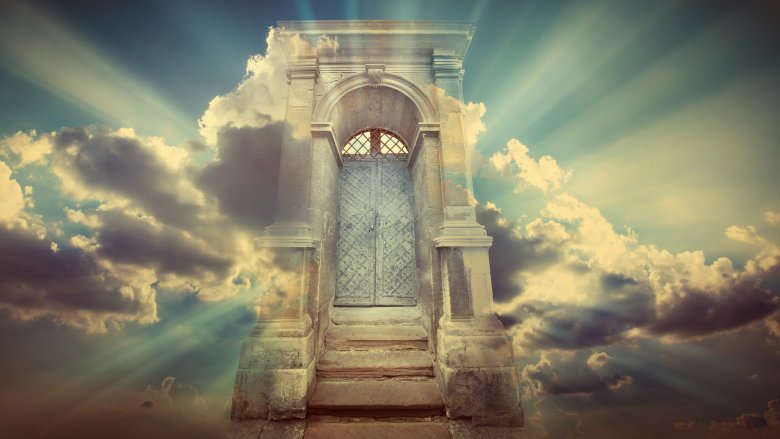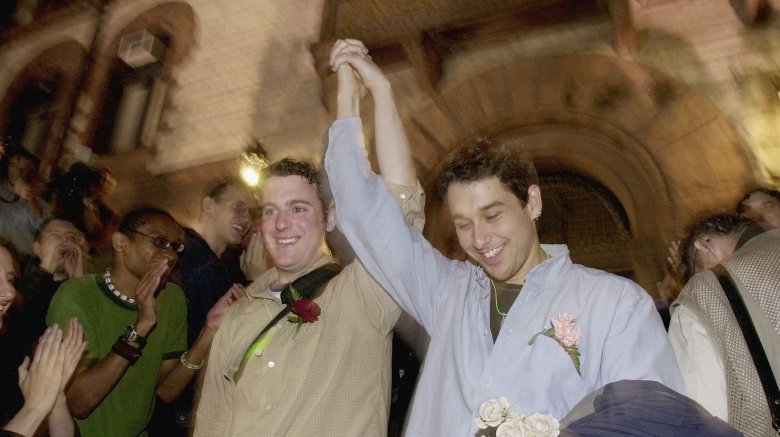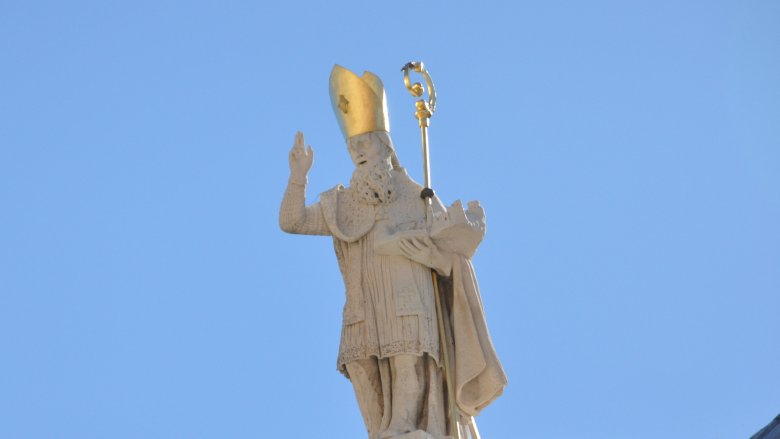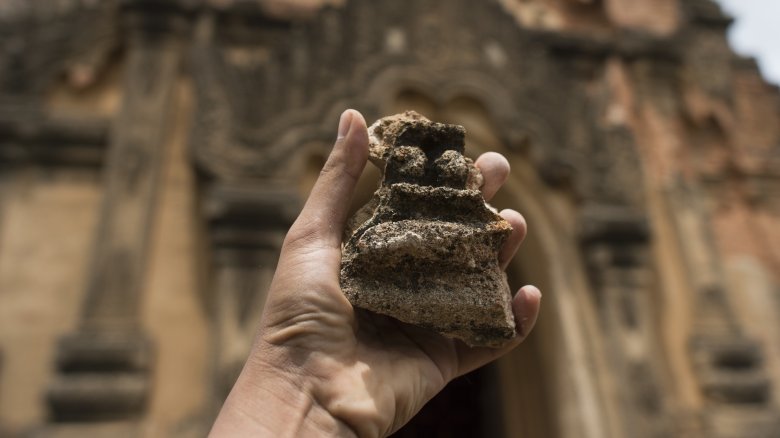False Facts About Ancient Religions You Always Thought Were True
Religion is our spiritual nourishment serving as a strength to sustain us through the hardest times. Thing is you've got to take it on faith. You can't see, touch, or taste it. There are books, rabbis, imams, and priests to help guide you but ultimately, it's a personal matter between you and the intangible. The other thing about religion is it's been handed down through the centuries, across a few different languages, and shared by people that haven't always agreed on its meaning.
When you sit down to partake in this delicious communal gumbo, keep in mind that there have been a lot of cooks in that kitchen. The recipe you enjoy today may have a little more or less of the proverbial paprika than what was served in times past.
As a little food for thought, here are some facts about religions that haven't always been true.
Priests could never marry
It was Paul McCartney who sang of Father Mackenzie "darning his socks in the night when there's nobody there." The good priest was alone, no Mrs. Mackenzie to give a darn because Catholic priests can't marry, of course. They forgo it in devotion to God. At least, that's how it's been lately. There was a time when priests were as free as anyone to be husbands.
In the early A.D. days, priests still knew the bliss of endless compromise and physical pleasure with a spouse. That started to change in 306 at the first Council of Elvira when, as explained by former dean of the Notre Dame Graduate School of Christendom College Fr. William Saunders, the subject of clergy marriage was raised. It was still allowed, but the Church began pushing for chastity among the clergy, a white martyrdom in faith as opposed to the red martyrdom of being killed for it.
The last legs of a priest's wedding march were kicked out in the 11th century as part of the Gregorian reforms. Priests who could not live celibate lives were seen as lacking moral authority. The church was growing and wanted to shore up its authority as a moral leader. According to some scholars, this even helped make the case for the Crusades, which were not exactly a high point in morality.
Hell has been there from the start
The fiery pit of eternal torment where Grandma condemned you for sneaking that cookie. The stick to Heaven's carrot. Do good in life or burn for all time. Hell.
Truth is, faith took a while to heat up. The Old Testament of the Christian Bible, which is also shared by Judaism and Islam, contains the story of creation, the first humans, the first murder, and horrendous acts of violence, but no Hell. Jews and Muslims never quite got on board with flame pits, and not just because they don't dig swine.
Universalist theologian Thomas B. Thayer explained in 1855 that, in the beginning, there was Sheol, a place for the dead. Its closer to shame or depression but not an afterlife. Sheol was not the least bit metal. The fires of hell were actually lit in Gehenna, where the dead beasts and executed criminals were left to burn. According to Christian author William West's research, this was "the severest judgment which a Jewish court court could pass upon a criminal." A place of punishment, neverending fire and the dead burning? Now, that's metal and much more like what Granny threatened you with.
Centuries later, the New Testament unveiled the idea of a multiple-choice afterlife. Luke 16:24: "For I am in agony in this flame." Whether God finally got things up to temperature or folks were still misreading an old Jewish dumpster fire is unclear. Best be good, for goodness' sake.
All religions bury their dead
"For you are dust, and to dust you shall return." Genesis 3:19. For the symbolism of the Old Testament, the expediency of covering the deceased, or the necessity in putting off wild animals from the scent of rotting flesh, burying the dead has been a custom throughout history. Some, by Time's reporting, see the Earth as sacred and not meant to be filled with the dead. Others see a quicker path to Heaven.
Buddhists and followers of Zoroastrianism practice sky burial. While it sounds romantic, a sky burial is actually leaving the dead to be devoured by birds of prey. Buddhists want to free the spirit, while Zoroastrians are trying to keep the Earth clean.
The Buddhist tradition, detailed by Tibet Vista, involves praying over the body before bringing it out, cutting it, and smashing it. The body breakers laugh as they work, to help the spirit transcend. The family isn't present because they would only anchor the spirit. Incense is left burning, letting the vultures know it's time to eat. Zoroastrianism's way starts out similarly but ends in a chamber with a layered filtration system. Per Al Jazeera, this breaks the bones down, returning them cleanly to the Earth.
If coffins give you claustrophobia, consider traveling in your old age. It may leave you with an everlasting peace.
Buddhism abhors violence
The most famous example of a Buddhist is either the Dalai Lama, smiling and serene, or Thich Quan Duc setting himself on fire to protest the Buddhist crisis in Vietnam. Buddhists are pacifists, believing in karmic reincarnation. The first of their five moral precepts is to abstain from taking life. But the wages of karma afford some interpretation on the value of a life.
As historian Peter Harvey explains, there are texts that allow for murder, even stories of the Buddha taking one life to spare others. There is room on the karmic wheel for compassionate violence. "Killing one in order to warn a hundred is not a violation of the precept of non-killing. It is a meritorious action to save the lives of human beings" says one Buddhist sermon. Sometimes the least of all evils is to take on the karmic debt of murder, slowing one's progress to Nirvana but sparing others that burden.
During World War II, Zen Buddhism was the theological backbone that Japan relied upon to shore up morale, steeling themselves as they prepared for suicide attacks. As reported by the New York Times, Buddhists "conducted fund-raising drives to purchase military aircraft." Not directly violent but certainly not pacifist. It also keeps with the tradition of ancient warrior monks who have been fighting in Japan for over a thousand years.
There's no one path to Nirvana, and in some cases even holy men will fight to get there.
Hinduism is called Hinduism
One of the world's oldest religions is Hinduism. It's most closely associated with the Bhagavad Gita, Ghanesh, and Yoga. It's also associated with the word Hinduism. That's not its name.
Despite the fact that everyone calls it Hinduism, it's the Sanata Dharma, though Brahmanism or Vedantism are also acceptable. Religious scholar David Lorenzen blames the Persians for the mixup. They first encountered this faith by the Sindhu river, but in their pronunciation it became "Hindu" because sometimes history is just that voice talking over everyone else.
That being said, why hasn't anyone made an effort to correct this for the past few thousand years? Well, the nature of Sanata Dharma itself. One way to interpret Sanata Dharma is something forever held, without beginning or end. In other words, who are they to be starting something?
As Merriam-Webster puts it, "truth is of such a nature that it must be multiply sought, not dogmatically claimed." It really isn't the way of Dharma to worry about semantics. Just live your best life and approach God in your way. Let faith be faith by any name.
All ancient religions disapprove of homosexuality
"You must not have sexual intercourse with a male as one has sexual intercourse with a woman; it is a detestable act." Leviticus 18:22. Being gay and of faith is never easy, particularly when your faith is one of the ancient religions. That quote is from the Old Testament, the bedrock of several religions. And while its teachings are widespread, they aren't the only ones out there.
Taoism, a Chinese belief system is home to the Rabbit God, Tu'er Shen. The story goes that in the 18th century, a man named Hu Tianbao was beaten to death for loving another man. The lord of the underworld raised Hu Tianbao up as Tu'er Shen, charging him with the watching over men who desired other men. Tu'er Shen prefers offerings of sugar and pork intestines and is said to be a gracious deity.
Additionally, from Ancient Egypt we have an interesting exchange between two gods, as Seth compliments Horus, "How beautiful are thy buttocks." Here we have two deities, technically beyond gender but depicted as masculine, enjoying one another from head to toe. When most religious canon holds same-gendered love to be a sin, even a single piece of pleasurable papyrus can be gratifying.
Religions enjoy images of faith
Looking around, there's no shortage of religious iconography from Renaissance artwork, to stained-glass windows, right up to Yeezy's Jesus piece. God even does commercials. Maybe that's what religions were looking to avoid when drawing Yahweh or depicting the face of God were considered sinful and forbidden. The Abrahamic faiths didn't advertise.
The fear was these images broke the Second Commandment, which prohibited making images to worship. Worse, what if your prayers went to the image and not your god? According to the Catholic Encyclopedia, this was too close to how pagans worshiped. Virtue aside, there was a practical reason: money. As Jeffrey Spier explains in his book Picturing the Bible, "The poverty and status of the Christian community denied it the possibility of commissioning works of art."
Judaism and many Muslims still keep away from images. Most Muslims refuse to depict the face of Allah or Muhammad. Judaism prefers to write G-d for fear of having to ever erase his name. Catholics were debating even up until 1866, as recorded by Bishop Rev. L. Meurin, who argued that artistic interpretations of the scriptures could help spread the word and deepen understanding.
Meanwhile, the BBC tells of a beautiful mosaic of Jesus' face in Dorset laid into the floor several hundred years ago. Whichever side you stand on, the image issue stills asks us to tread lightly.
Saints are the best people
The word "saint" conjures the idea of a good person. One who gives their last dollar to someone less fortunate. There are actual rules to becoming a saint, and it can take a few centuries to be canonized. Those centuries must help because, looking back, saints were into some weird stuff more fitting reality television than reverence. It's common in the lives of saints to find hardcore fasting, the faithful pushing themselves to the limits of physical endurance in extreme penance. Then there's Saint Macarius the Younger.
The Lives of The Saints tells us that he mastered starvation: "For seven years together he lived only on raw herbs and pulse." (Pulses are seeds like lentils.) Then he accidentally killed a gnat and was so mortified that he ran to a swamp, where he lived naked for six months at the mercy of stinging insects until "his whole body [was] disfigured by them." Nearer my God to thee.
If body horror isn't your cup of tea, meet Saint Simeon Stylites the elder, a saint because he got high. New Advent has compiled his path to sainthood. He stood on a series of columns, each higher than the last, getting food from his followers, finally dying on the last one after 36 years. Not to discount his good works, but it takes something special to climb into history by just standing there.
Abortion is the ultimate sin
When it comes to abortion, religion does not waver. It's firmly on the side of life, no matter which way you parse history. No means no, not counting those few centuries where it was a maybe before becoming a probably. But it definitely landed on no ... depending upon when life starts, according to Christian historian O.M. Bakke.
The abortion debate is not new. Thousands of years of discussion and thought have gone into deciding the church's official stance. Aristotle and Saint Thomas Aquinas both worked with the idea that from conception to birth, the fetus has a succession of different souls: vegetative, animal, then rational. Along that line of thinking was the debate over whether a baby was made and ensouled with bits of parental soul or just made and left there until God deposited a soul. There was quite a gray area over when to punish and what exactly to punish for.
Also, according to sociology professor Michelle Dillon, there was no church law against abortion until the council of Elvira in the early 300s. Even then, there was back and forth over the developmental stages of the fetus. It wasn't until 1869 that Pope Pius IX announced excommunication as punishment that the church started to exchange nuance for just saying no.
Religions were whole from the start
There's so much religion in the world, it's hard to imagine a time when the Commandments weren't carved, nobody was praying for winning numbers on Facebook, and atheists weren't ruining freshman philosophy courses. But none of the ancient religions arrived complete. They may not want to admit it, but there are many fixer-upper faiths.
Christians worship Christ, they just didn't know whether he was a person with some God in him or a God with some person in him. As scholar Jonathan Wilson explains, it took humans about 300 years to decide he was both. The Catholic Herald reports that the world's churches still haven't finalized when Easter was, though they really narrowed it down in 664. The Catholic catechism says that about 400 years after that, Purgatory came along, a place between Heaven and Hell that was added like an in-law apartment. There was a theory of limbo, a place for the souls of unbaptized newborns, that was tossed in 2007. The Pope still has no idea where these kids are.
Unless they work at a kosher deli, Jews probably aren't slaughtering animals like they used to. Islam is followed by Shiites and Sunnis because, after the death of Muhammad, they couldn't decide who to follow.
Maybe religion is perfection itself that we keep touching without washing our hands, or maybe the better angels of our nature need to agree to let the finer points go and not mind the devils in these details.










